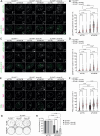This is a preprint.
SLX4IP acts in parallel to FANCM to limit BLM-dependent replication stress at ALT telomeres
- PMID: 40501906
- PMCID: PMC12154878
- DOI: 10.1101/2025.05.28.656696
SLX4IP acts in parallel to FANCM to limit BLM-dependent replication stress at ALT telomeres
Abstract
Alternative Lengthening of Telomeres (ALT) is a telomerase-independent telomere maintenance mechanism that enables cancer cells to gain unlimited replicative capacity. ALT relies on recombination-mediated telomere elongation and is promoted by telomeric replication stress. However, ALT requires strict regulation, as excessive replication stress or recombination are cytotoxic. Central to ALT is the RecQ helicase BLM, which regulates telomeric replication stress and promotes telomere recombination and DNA synthesis. Despite its key role in the ALT pathway, BLM must be tightly regulated to prevent deleterious outcomes. Here, we identify SLX4IP as a key suppressor of BLM-driven replication stress at ALT telomeres. Loss of SLX4IP in ALT-positive cells leads to BLM-dependent telomeric replication stress and impaired replication fork progression. Mechanistically, SLX4IP limits the unwinding of unligated Okazaki fragments by BLM on the lagging strand during telomere replication. This reduces the formation of toxic 5' DNA flaps and prevents hyperactivation of ATR signalling and deleterious recombination levels. We also uncover a synthetic lethal interaction between SLX4IP and FANCM, an ATPase/translocase that is a known regulator of BLM at telomeric replication forks in ALT cells. We demonstrate that SLX4IP and FANCM act in parallel to restrain BLM activity, thereby maintaining the balance of replication stress and recombination that is necessary for productive ALT. These findings reveal a vulnerability in ALT-positive cancers lacking SLX4IP and establish SLX4IP as a potential biomarker for therapeutic strategies targeting FANCM.
Keywords: ALT; BLM; FANCM; SLX4IP; cancer; genome stability; lagging-strand replication; replication stress; telomere.
Conflict of interest statement
DECLARATION OF INTERESTS The authors declare no completing interests.
Figures




Similar articles
-
The single-stranded DNA-binding factor SUB1/PC4 alleviates replication stress at telomeres and is a vulnerability of ALT cancer cells.Proc Natl Acad Sci U S A. 2025 Jan 14;122(2):e2419712122. doi: 10.1073/pnas.2419712122. Epub 2025 Jan 7. Proc Natl Acad Sci U S A. 2025. PMID: 39772744 Free PMC article.
-
DNA2 and FANCM function in two distinctive pathways in disrupting TERRA R-loops and suppressing replication stress at ALT telomeres.bioRxiv [Preprint]. 2025 May 24:2025.05.22.655602. doi: 10.1101/2025.05.22.655602. bioRxiv. 2025. PMID: 40475582 Free PMC article. Preprint.
-
Distinct mechanisms underlying extrachromosomal telomere DNA generation in ALT cancers.Nucleic Acids Res. 2025 Aug 11;53(15):gkaf771. doi: 10.1093/nar/gkaf771. Nucleic Acids Res. 2025. PMID: 40795958 Free PMC article.
-
Comparison of Telomere Structure in Eukaryotes.Arch Razi Inst. 2024 Dec 31;79(6):1365-1374. doi: 10.32592/ARI.2024.79.6.1365. eCollection 2024 Dec. Arch Razi Inst. 2024. PMID: 40606259 Free PMC article. Review.
-
Adefovir dipivoxil and pegylated interferon alfa-2a for the treatment of chronic hepatitis B: a systematic review and economic evaluation.Health Technol Assess. 2006 Aug;10(28):iii-iv, xi-xiv, 1-183. doi: 10.3310/hta10280. Health Technol Assess. 2006. PMID: 16904047
References
-
- Bryan T. M., Englezou A., Dalla-Pozza L., Dunham M. A. & Reddel R. R. Evidence for an alternative mechanism for maintaining telomere length in human tumors and tumor-derived cell lines. Nat Med 3, 1271–1274 (1997). - PubMed
-
- Henson J. D. & Reddel R. R. Assaying and investigating Alternative Lengthening of Telomeres activity in human cells and cancers. FEBS Letters 584, 3800–3811 (2010). - PubMed
Publication types
Grants and funding
LinkOut - more resources
Full Text Sources
Miscellaneous
